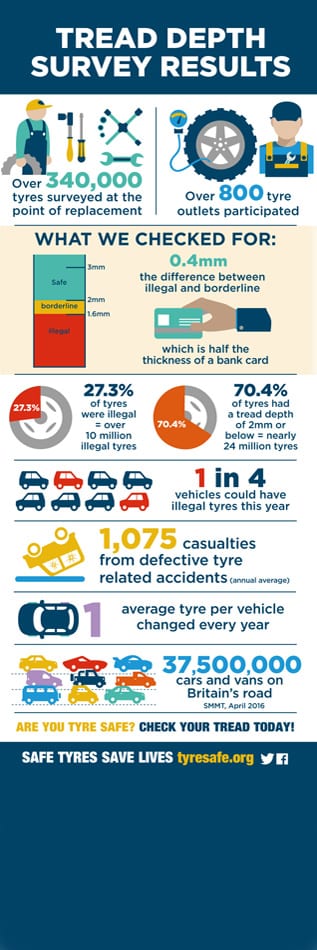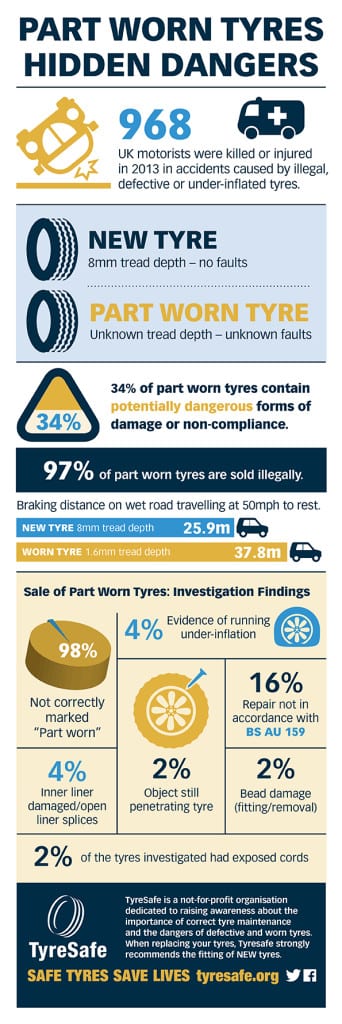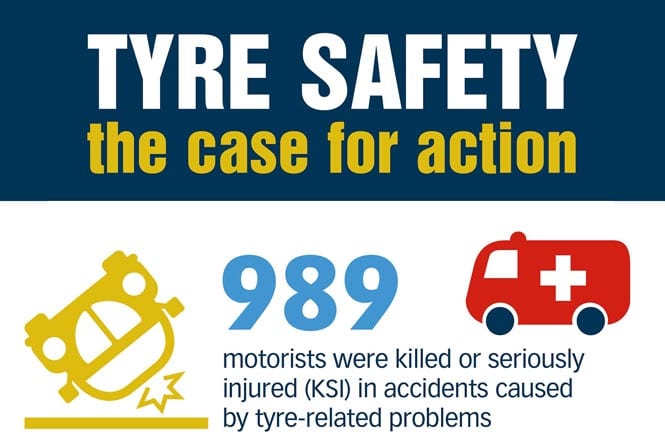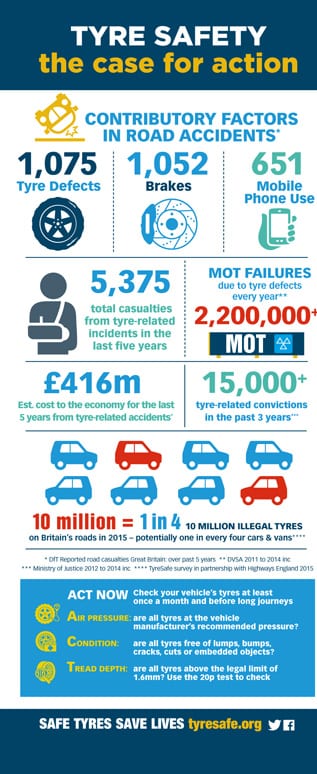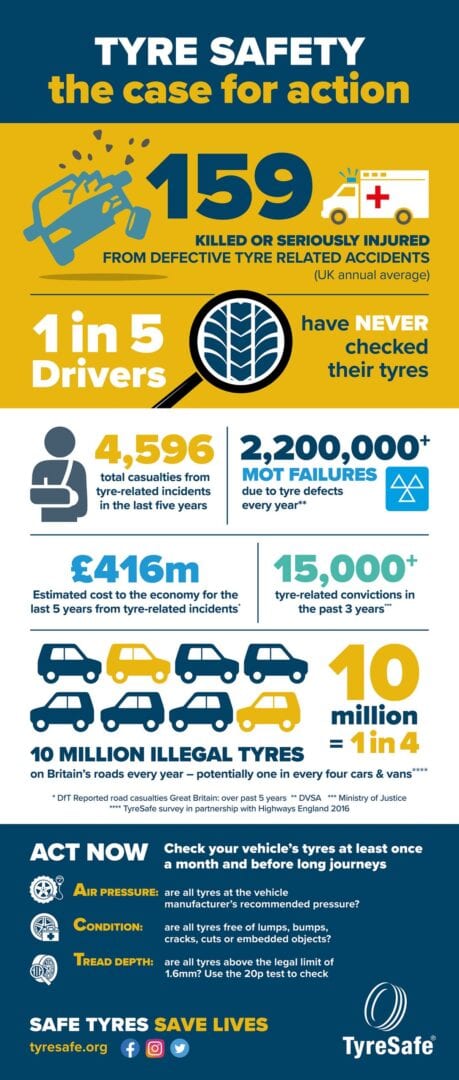
TyreSafety Case for Action
- 159 killed or seriously injured from defective tyre-related accidents.
- 1 in 5 drivers have never checked their tyres.
- 4,596 total casualties from tyre-related incidents in the last five years.
- 2,200,000 MOT failures due to tyre defects every year.
- £416m. Estimated cost to the economy for the last 5 years from tyre-related incidents.
- 15,000 tyre-related convictions in the past 3 years.
- 10 million illegal tyres on Britain’s roads every year – potentially one in four cars & vans.

Tread Depth Survey Results
- Over 340,000 tyres surveyed at the point of replacement.
- Over 800 tyre outlets participated.
- 0.4mm. The difference between illegal and borderline which is half the thickness of a bank card.
- 27.3% of tyres were illegal = over 10 million illegal tyres
- 70.4% of tyres has a tread depth of 2 mm or below = nearly 24 million tyres.
- 1 in 4 vehicles could have illegal tyres this year.
- 1. Average tyre per vehicle changed every year.
- 159 people killed or seriously injured from incidents involving defective tyres.
- 37,500,000 cars and vans on Britain’s roads.
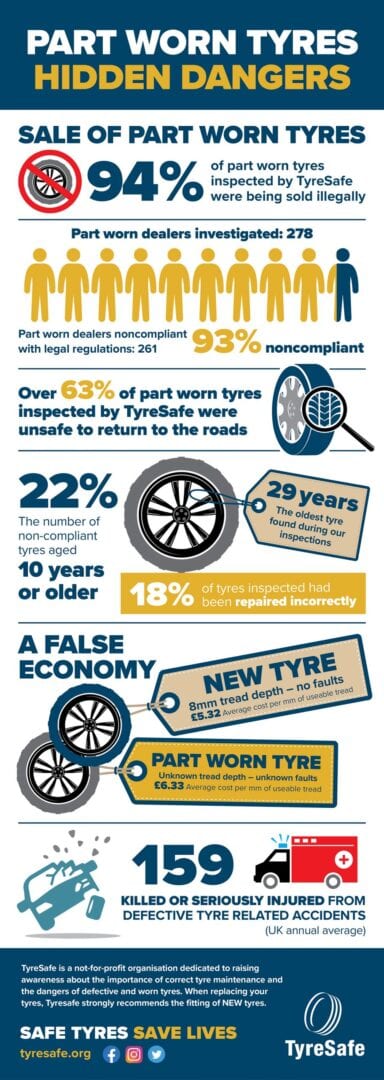
Part Worn Tyres. Hidden Dangers.
- 94% of part worn tyres inspected by TyreSafe were being sold illegally.
- Part worn dealers investigated: 278
- Part worn dealers non-compliant with legal regulations: 261. 93% non-compliant
- Over 63% of part worn tyres inspected by TyreSafe were unsafe to return to the roads.
- 22%. The number of non-compliant tyres aged 10 years or older.
- 29 years. The oldest tyre found during our inspections.
- New Tyre. 8mm of tread – no faults. £5.32 Average cost per mm of useable tread.
- Part Worn Tyre. Unknown tread depth – unknown faults. £6.33 Avergae cost per mm of useable tread.
- 159 killed or seriously injured from defective tyre-related accidents.

Van Tyre Safety Transcript
Did You Know?
Van sales have surged nearly 60% since 2000, with over 4 million vans on UK roads, contributing £56 billion in wages. Britain runs on tyres.
Overloading is risky and common, leading to fines and prohibitions. It makes vans unstable and damages tyres, causing potential failures.
Check your van’s weight and tyre load index in the handbook. Ensure proper tyre pressure to enhance safety, save fuel, and reduce emissions.
Regularly inspect tyres for damage and maintain tread depth above 1.6mm. Follow tyre safety checks to keep you and your van safe. Britain works on tyres.

Driving in the Rain
- 517.6 mm. Amount of rainfall in the UK during winter 2013, making it the wettest winter since records began in 1910.
- 7 seconds. Typical time taken for a car’s tyres to clear enough water to fill a bucket in wet weather.
- October 12th – Wettest day in 2013 with 73mm of rainfall
- 168. Number of days in 2013 where rainfall fell in London
- Braking distance on wet road travelling at 50mph to rest
- New tyre 8mm tread depth. 25.9m
- Worn tyre 1.6mm tread depth. 37.8m
- Number of road casualties in the UK in 2012 caused by illegal, defective or under-inflated tyres – 1238
- 205/55R16 The most common size of tyre in the UK
- 3 points can be added to your licence for each illegal tyre
- 170 average number of convictions at magistrates court in England and Wales each week in 2012 for defective tyres
- £2500 – The maximum possible fine for each tyre if convicted for driving with illegal tyres
- 20p coin used to check tyres have legal tread depth
- 1.6mm legal minimum tread depth for tyres in the UK
- 1. Check your tyres at least once each month
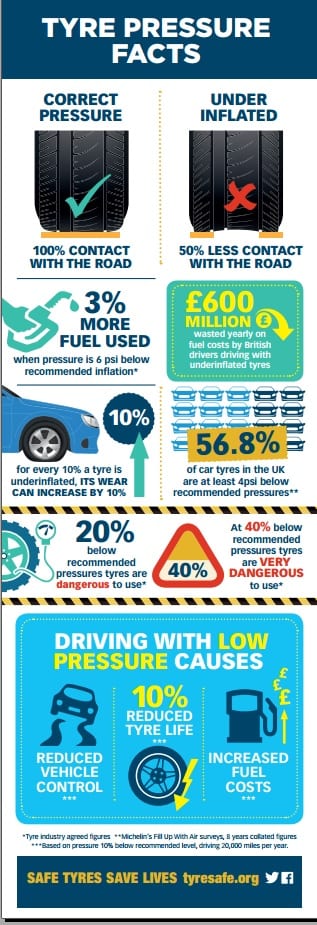
Tyre Pressure Facts
- Correct pressure – 100% contact with the road
- Underinflated – 50% less contact with the road
- 3% more fuel used when pressure is 6psi below recommended inflation
- 56.8% of car tyres in the UK are at least 4pdi below recommended pressures
- 20% below recommended pressure tyres are dangerous to use
- Driving with low pressures causes
- Reduced vehicle control
- 10% reduced tyre life
- Increased fuel costs
